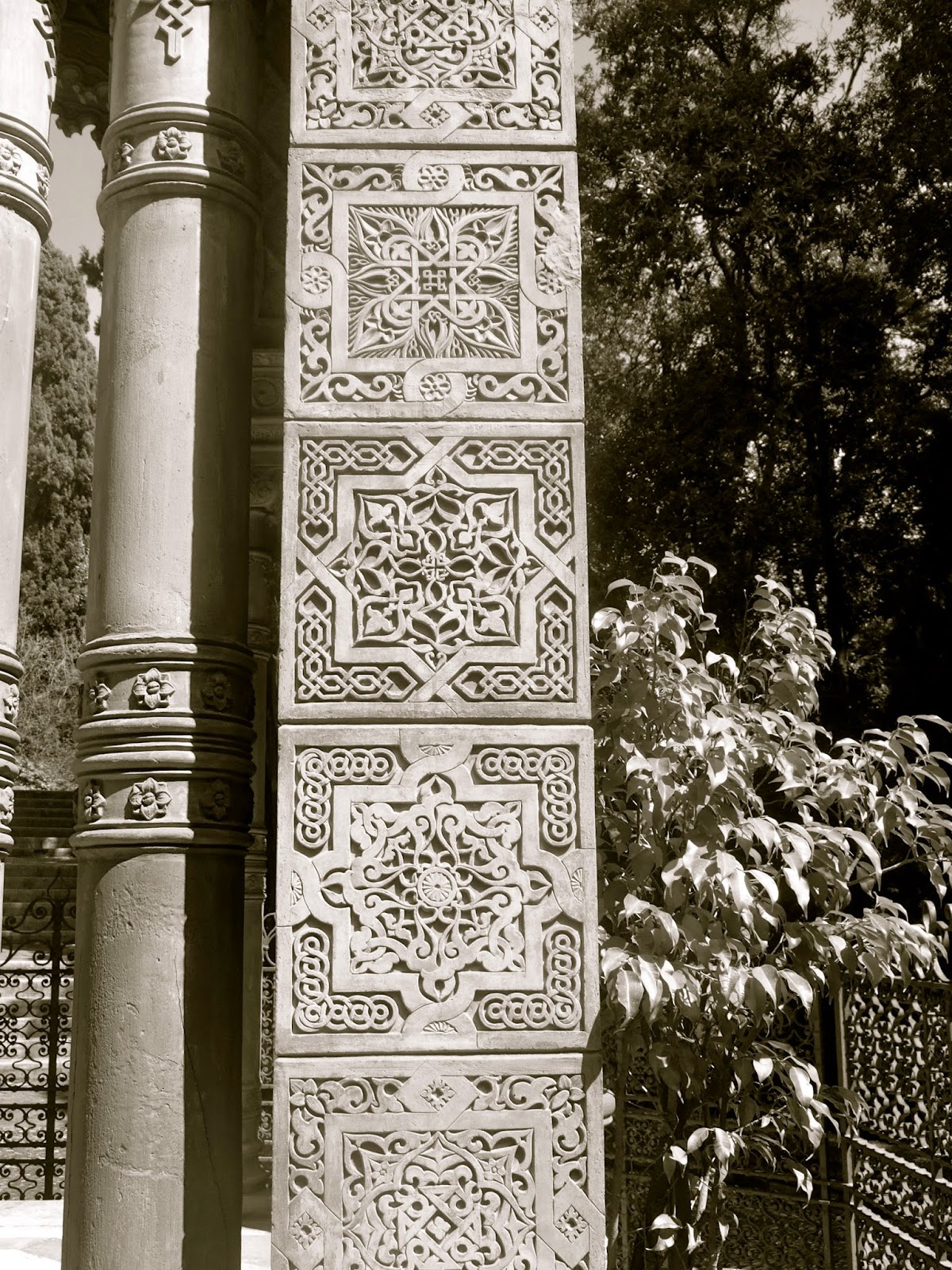What made it fabulous was the improbability of building an Eden on such a dry slope.
(Seen from above) "It is as if the garden has been folded into a fissure in the rock...the effects of water on limestone may have worn away a cosy niche for the palazzo, but the soil it has created is heavy, clay-like and not suited to many plants, which prefer a more acidic medium. It is a burnt-cream colour and, once dry, it cracks like subsiding plaster. In the summer the soil sets hard, clamping plants in its rocky grip, while rain or irrigation runs slickly off its surface. Any moisture absorbed drains quickly from the sloping ground." (La Mortola: in the Footsteps of Thomas Hanbury by Alasdair Moore)Carved out of a steep slope rising 103 metres from the Mediterranean it was not the easiest site to garden. Terraced gardening is not for the faint of heart or weak of muscle. Still standing are the ancient retaining walls, esplanades and old brickwork boundary which separates the Roman villa from the sea. But it's a never-ending process and impossibly hard work. The regional geography, however, works in the botanist's favor by providing the mildest climate north of Egypt and water, though scarce, springs from the snows of the nearby Ligurian Alps. Tropical plants abound here, in fact this garden is the source of the Riviera's early fascination with palm trees.
"What Sir Thomas Hanbury had started, with more ambitious and scientific objectives, in his botanical garden at La Mortola, was reproduced - out of emulation, as a mark of prestige, or for aesthetical reasons - practically everywhere in the gardens along the western riviera." (From the current Unesco list of tentative sites. Villa Hanbury was nominated for Unesco status in January, 2006, along with Orvieto, and the historic centres of Lucca and Parma.)
Hanbury was the classic Victorian amateur botanist, collecting plants from all over and introducing them to his garden. To propagate them (a Victorian obsession with the secrets of reproduction crops up often in accounts from this time) often required patience and creativity when the native propagators from Africa, Asia and/or South America weren't available. Australian plants, especially eucalyptus, were one answer to this harsh environment. And eucalyptus had "febrifugal" qualities, good for counteracting the scourge of malaria. This garden was to be a living laboratory, completely out of doors, where pharmaceutical plants from around the globe could be propagated and studied for future medical availability. Drought-tolerant succulents like the agaves and aloes form the backbone of much of the garden and are historically critical components of Central and South American pharma-culture.
I learned a lot about gardens the afternoon I spent this April at Villa Hanbury. Much like the townscape in a city, they can be broken into basic elements, some of which I include here as they suggested themselves to me through my photographs from that afternoon in April.
Prospect and View
 |
| The Mediterranean Sea provides a view of Corsica on clear days. |
Paths
Arguably the most important element in a difficult environment, they're all laid out according to the original Roman road, the Via Julia Augusta. A road Dante, it is said, once strode upon.
 |
 |
| Shaded pathways are welcome in the hot sun |
 |
 |
| Evergreens also provide protection from marine winds |
Monuments
 |
| Wisteria in April outside the Palazzo Orengo |

 |
| The Moorish Kiosk, planned and built in 1886 by San Remo architect Pio Soli. Here lie the ashes of Thomas Hanbury and his wife Katharine Pease. |
 |
| Mosaic of Marco Polo, designed in 1888 by Salviati |
 |
| The Tempietto |
Water
 |
| Dragon Fountain with papyrus, traditionally grown for paper-making in Egypt. |
Collections and Specimens
This is what Villa Hanbury is really known for. There are 5800 species in Hortus Mortolensis.
Daniel Hanbury, Thomas' brother, planted a Casimiroa edulis in 1867, the first year of planting the garden. It came from the Central American plateau and was "highly esteemed by the early settlers because of its edible fruit and the hypnotic properties of the flour obtained from the fruits....In the early years Thomas left his eldest brother Daniel to continue the development of the garden while he was engaged in his business activities. In this period many plants that were not only decorative but also of pharmaceutical and economic interest were introduced." (Hanbury Botanic Gardens brochure)
 |
| The agave flower, a common site throughout the Riviera. Only once in their lives do they flower, producing a flowering stem that can achieve heights of 12 metres. |
 |
| Agave is the source of tequila, originally called pulque, which played an important role in the Aztecs' culture, fuelling many of their religious ceremonies. |
 |

 |
| Aloes, useful for wounds and digestion. |
In the early years the Ligurians who lived in the surrounding area were mistrustful of foreigners who planted ornamental gardens and weren't inclined to maintain gardens as fiercely productive as those of the natives. However, the Hanburys fostered ancient citrus orchards which produced pummelo, lumia, citron, Mauritius papeda, bergamot, bitter orange, sweet orange, lemon, grapefruit, mandarin, tangerine and kumquat as well as the quince, the loquat, raisin tree, avocado, feijoa, mountain paw-paw, guava, macadamia. In addition there are local fruit trees including the service tree, the azarole, the jujube, the medlar and the pistachio.
Also in the collection are outstanding cycads whose origin is very ancient, existing during the Mesozoic Era (between 200 and 100 million years ago)
Repose and Accommodation
 |
| Sojourners have walked the important Via Julia Augusta for centuries. Archaeological finds are accomodated and given a home in the garden. |
 |
| One of many opportunities to rest and reflect |








































